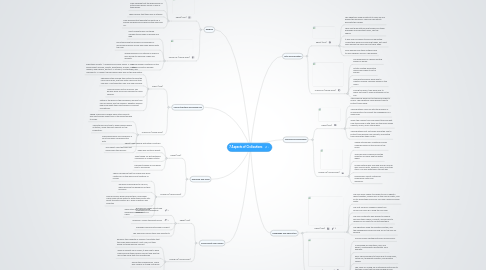
1. Economy and Trade
1.1. Egypt (Nile)
1.1.1. Egypt traded goods with other countries.
1.1.2. Trade was limited in Egypt.
1.1.3. They traded for gifts between individuals of unequal status.
1.1.4. Merchants sailed up and down river to sell goods.
1.2. Huang He (Yellow River)
1.2.1. There is evidence that the Shang may have created on of the world's first systems of money
1.2.2. The Zhou learned how to use iron, which became the backbone of their economy
1.2.3. Their economy grew because their crops grew. China used natural water to water their plants until about the sixth century B.C. when irrigation was invented
1.2.4. Agriculture and metalworking developed independently in China
2. Social Structure and Family Life
2.1. Egypt (Nile)
2.1.1. Egyptians society: 1. Pharaoh's and royal family. 2. Key government officials, priests, priestesses, scribes, military leaders, land owners, doctors. 3. Artisans, craftspeople, and merchants. 4. Peasant farmers which was 90% of the population.
2.1.2. Pharaohs often married their sisters to keep the royal blood pure, and they often had more than one wife. Most Egyptian men only had one wife.
2.1.3. Lived as family units in a house. The houses differ form poor families to noble families.
2.1.4. Father is the head of the household, women took care of homes and the children. Egyptian women had more rights than most women in ancient civilizations.
2.2. Huang He (Yellow River)
2.2.1. Shang China was a largely agricultural society and most people spent time in the fields tending to crops.
2.2.2. The elite had free time to spend doing leisure activities, unlike the vast majority of the population.
2.2.3. Shang kings were surrounded by a court and were considered the elite.
2.2.4. The lowest class that were not slaves were the farmers.
3. Government and Leaders
3.1. Egypt (Nile)
3.1.1. Bureaucracy-highly structured organizations managed by officials.
3.1.2. Pharaohs- means the great house.
3.1.3. Pharaohs had absolute power in Egypt.
3.1.4. The Pharaohs choose their loyal assistants.
3.2. Huang He (Yellow River)
3.2.1. Ruled by the Mandate of Heaven: this states that the Gods would support a just ruler, but they would not allow anyone corrupt
3.2.2. When a dynasty fell in China, it was said to have been because they became corrupt and was the will of the Gods that it be overthrown
3.2.3. During the Shang period, China was ruled by a strong monarchy
3.2.4. Shang kings were surrounded by a court (gathering of wealthy nobles who performed rituals intended to strengthen the kingdom and keep it safe)
4. Religion
4.1. Egypt (Nile)
4.1.1. Their religion was a complex system of polytheistic beliefs and rituals.
4.1.2. They believed that the phenomena of nature were divine forces in and of themselves.
4.1.3. They believer that there was a afterlife.
4.1.4. They believed that beneath the earth lay a parallel underworld and beyond the skies was Nu.
4.2. Huang He (Yellow River)
4.2.1. Most Shang tombs contained valuable items made of bronze and jade
4.2.2. Each tomb held the remains of hundreds of sacrificed prisoners of war who were buried with the ruler
4.2.3. Shang believed in an afterlife in which a ruler would still need his riches and servants
4.2.4. Shang religion centered on the idea of ancestor worship
5. Arts and Education
5.1. Egypt (Nile)
5.1.1. The Egyptians used architects to work on and design the pyramids. They also had artists decorate the insides.
5.1.2. They built huge statues and temples for there pharaohs and important rulers, like the sphinx.
5.1.3. It was rare for people to become educated. Unless they were boys learning trades, but most sons learned the same jobs as there Dads.
5.1.4. Girls learned from their mothers how to raise children and run a household.
5.2. Huang He (Yellow River)
5.2.1. The beginning of Chinese writing began on bones.
5.2.2. Artists created decorative vessels and objects out of bronze.
5.2.3. Shang astronomers were able to create a precise calender based on the moon.
5.2.4. During the Zhou, they were able to figure out how to make metalwork out of iron.
6. Geography and Agriculture
6.1. Egypt (Nile)
6.1.1. The Nile River makes it possible to live in Egypt's desert weather, people rely on the Nile for water, and for its predictable floods for rich farm lands and clean water.
6.1.2. The first farming villages in Egypt can as early as 5000 B.C along the Nile river
6.1.3. The Nile's cataracts help prevent invasions because there rapids, currents, and falls are to dangerous for boats to sail through them.
6.1.4. The Egyptians used the irrigation system, and the dependable floods and rich soil of the Nile for farming.
6.2. Huang He (Yellow River)
6.2.1. Annual floods created fertile soil around rivers.
6.2.2. Surrounded by mountains, hills, and desert, creating extra protection from enemies.
6.2.3. Early China was able to thrive due to long rivers, fertile soil, temperate climates, and isolated valleys.
6.2.4. The valley of Huang He is extremely fertile due to the type of soil that the river picked up and deposited.
7. Science and Technology
7.1. Egypt (Nile)
7.1.1. The Pyramids were built as tombs for Egypt's Rulers. The Egyptians made deadly traps to protect there kings.
7.1.2. The Egyptians came up with the process of mummification to prevent the breakdown of a dead body.
7.1.3. When the Hyksos took over Egypt they brought new technology's with them like the horse drawn chariots, armor, and a strong bow.
7.1.4. The Egyptians built fortresses along the Nile to protect their people from bandits, and hostile tribes along the trade routes.
7.2. Huang He (Yellow River)
7.2.1. Shang astronomers created a precise calendar based on the cycles of the moon
7.2.2. They had many advances like the invention of paper and the water wheel
7.2.3. Prized material was jade and bronze. Bronze was used for pots, weapons, bells, and other items. Iron was eventually used as well
7.2.4. Developed a secret method of making silk cloth from silkworms
